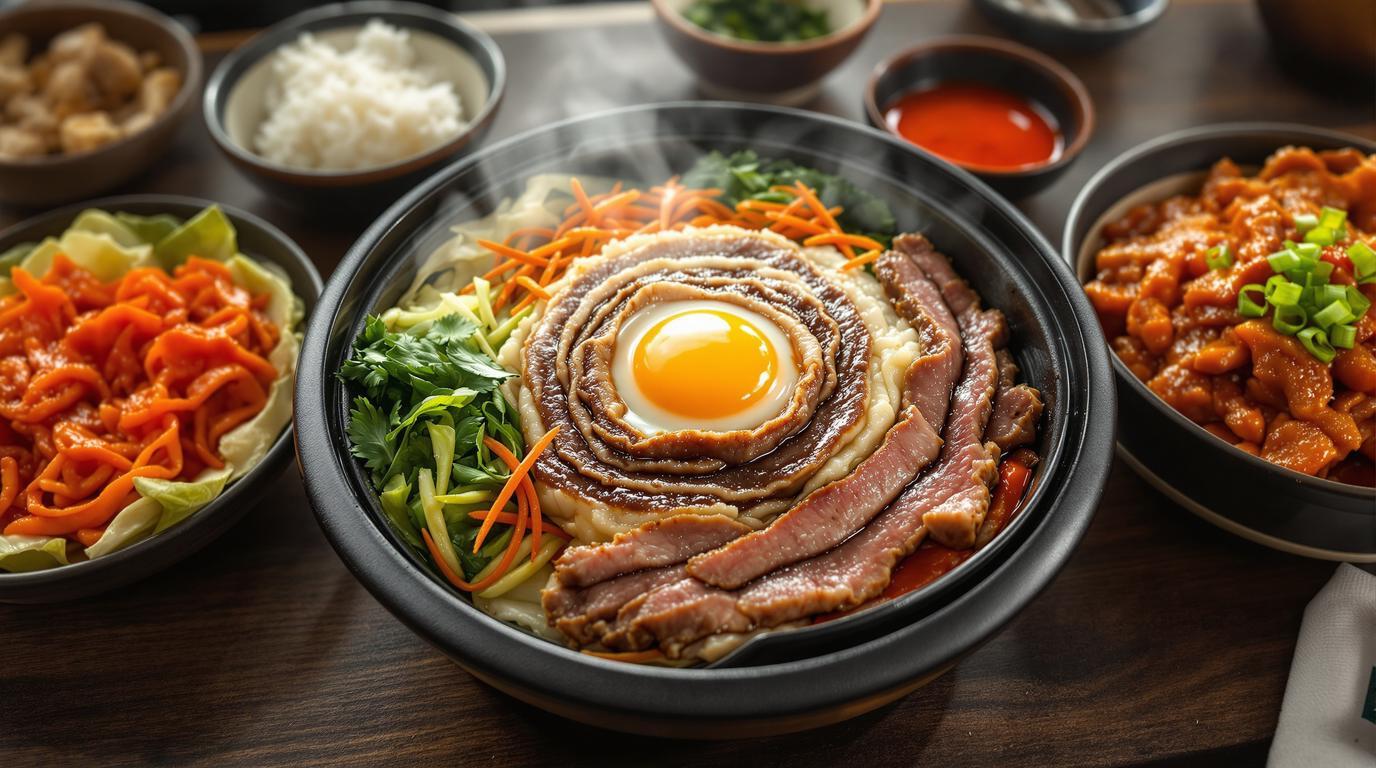There’s something magical about the bold, punchy flavors of Korean cuisine that takes me back to my first visit to Seoul nearly two decades ago. The vibrant harmony of spicy, sweet, salty, and umami notes danced across my palate in a way I’d never experienced before. Today, I’m sharing three cornerstone recipes that capture the essence of traditional Korean home cooking—dishes that have stood the test of time and continue to bring families together around the dinner table. These aren’t just recipes; they’re cultural touchstones that tell the story of Korea’s rich culinary heritage. 🇰🇷
Napa Cabbage Kimchi (Tongbaechu Kimchi) 🥬
Every Korean household has their own kimchi recipe, passed down through generations with subtle tweaks and adjustments. This fermented cabbage dish is more than just a side—it’s the beating heart of Korean cuisine.
Essential Ingredients:
- 2 whole napa cabbages (3 lbs/1.36kg)
- ½ cup coarse sea salt
- 2 cups Korean red pepper flakes (gochugaru)
- ½ cup minced garlic
- 2 cups Korean radish, cut into matchsticks
- ½ cup fish sauce
- ¼ cup salted fermented shrimp (saeujeot)
- ½ cup grated Asian pear or Fuji apple (optional)
Step-by-Step Instructions:
- Split each cabbage head in half lengthwise, then make a 2-inch cut at the base to help the salting process.
- Sprinkle salt between each leaf, focusing more on the thicker white parts. Let stand for 2-3 hours, turning every 30 minutes.
- Rinse cabbage thoroughly three times and drain for 1-2 hours in a colander.
- Make a paste by combining gochugaru, garlic, radish, fish sauce, fermented shrimp, and pear/apple.
- Wearing gloves, spread paste between each leaf, working from the outside in.
- Tightly pack kimchi into a clean container, pressing down to remove air pockets.
- Let ferment at room temperature for 1-2 days, then refrigerate for up to several months.
Chef’s Note: The quality of your gochugaru makes all the difference. Look for vibrant red, coarsely ground Korean pepper flakes—not the finely powdered variety often sold at general grocery stores. This single ingredient carries the signature flavor profile of authentic kimchi. If you find the process intimidating, start with a small batch using just one cabbage.
This living food evolves over time—fresh kimchi offers a crisp, bright flavor perfect alongside grilled meats, while aged kimchi develops deeper complexity ideal for stews. Try it with my 7-Hour Pork Roast for a beautiful contrast of flavors.
Spicy Pork Stir-Fry (Jeyuk Bokkeum) 🥩
There’s a reason this dish appears on dinner tables across Korea—its perfect balance of heat and sweetness makes it irresistible. The caramelized edges of the pork and the glistening sauce make this a true showstopper.
Essential Ingredients:
- 1 lb (450g) pork shoulder or belly, thinly sliced
- 3 tablespoons gochujang (Korean chili paste)
- 2 tablespoons gochugaru (Korean chili flakes)
- 2 tablespoons soy sauce
- 3 cloves garlic, minced
- 1 tablespoon honey or brown sugar
- ½ cup green onions, cut into 2-inch lengths
- ½ cup Asian pear, julienned (optional for sweetness)
Step-by-Step Instructions:
- Combine gochujang, gochugaru, soy sauce, garlic, and honey in a bowl.
- Add thinly sliced pork and marinate for at least 30 minutes (overnight is better).
- Heat a tablespoon of oil in a wide pan or wok over high heat until nearly smoking.
- Add pork in a single layer without overcrowding (cook in batches if needed).
- Let pork sear for 2-3 minutes before stirring to develop caramelization.
- Add green onions and pear in the last minute of cooking.
- Serve immediately, garnished with toasted sesame seeds and more sliced green onions.
Traditional Korean meals feature this dish alongside fresh lettuce leaves for wrapping, steamed rice, and an array of banchan (side dishes). For a quick weeknight version, try adapting techniques from my 10-Minute Skillet Pasta approach—quick cooking with maximum flavor.
Bibimbap (Mixed Rice Bowl) 🥣
This colorful rice bowl exemplifies Korean cooking philosophy—harmonious balance in flavor, texture, nutrition, and even color. The name literally means “mixed rice,” but it represents so much more.
Essential Ingredients:
- 2 cups (400g) cooked medium-grain rice
- ½ lb (225g) beef sirloin, thinly sliced
- ½ cup each: julienned carrots, sautéed spinach, bean sprouts, sautéed zucchini
- 4 eggs (for frying)
- 2 tablespoons gochujang sauce, plus more for serving
- 2 tablespoons toasted sesame oil
- 2 cloves garlic, thinly sliced and fried crispy
Step-by-Step Instructions:
- Season beef with soy sauce, garlic, and a touch of sugar. Sauté until just cooked through.
- Separately prepare each vegetable—lightly sauté with salt and sesame oil.
- Fry eggs sunny-side up until whites are set but yolks remain runny.
- Warm rice and place in individual serving bowls.
- Arrange vegetables and beef in separate sections around the rice.
- Place fried egg in the center and garnish with crispy garlic chips.
- Serve with gochujang sauce on the side for each diner to add to taste.
Chef’s Note: The true magic of bibimbap happens at the table when everything is stirred together, breaking the egg yolk to create a silky sauce that coats each grain of rice. For an extra-authentic experience, serve in a sizzling stone bowl (dolsot) that crisps the rice at the bottom.
This dish is endlessly customizable—try it with crispy Air Fryer Chicken Thighs instead of beef, or go vegetarian with extra mushrooms and tofu.
Korean cuisine teaches us that bold flavors don’t require complicated techniques—just quality ingredients and an understanding of balance. These three dishes form the cornerstone of traditional Korean home cooking, each offering a different dimension of flavor. From the probiotic-rich kimchi to the spicy-sweet pork to the harmonious bibimbap, they showcase the depth and breadth of this magnificent culinary tradition. Next time you’re looking for something to transform day-old ingredients into something magical, or a quick 30-minute recipe with maximum payoff, look to Korea’s time-tested traditions. Your taste buds will thank you. 🥢
